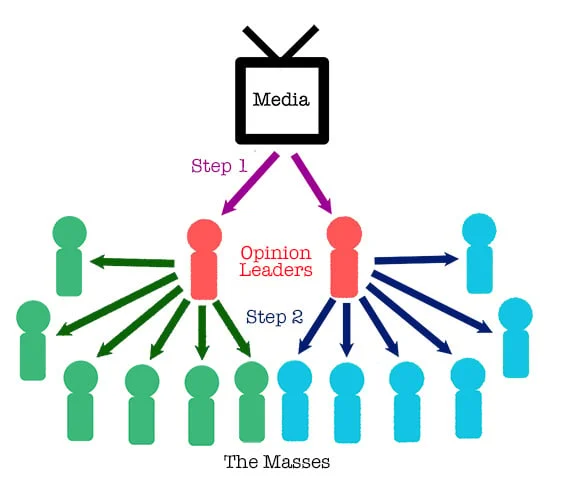When most people think about how the media influences others, they often picture it as a direct contact: the news or a brand puts out a message, and the audience just takes it in. But that’s not really how it works. The Two-Step Flow Theory, first developed by Paul Lazarsfeld, Bernard Berelson, and Hazel Gaudet in the 1940s and later expanded by Elihu Katz and Lazarsfeld in 1955, suggests that media doesn’t directly affect everyone at once. Instead, information usually passes through certain people first (known as opinion leaders) who then share or interpret it for others.

This idea came from Lazarsfeld’s study during the 1940 U.S. presidential election. The researchers expected to find that newspapers and radio broadcasts had a huge influence on how people voted, but they discovered something else: most people’s opinions were shaped by the people around them, not the media itself. Friends, family members, coworkers, etc, acted as mini “influencers,” explaining and passing on information. So instead of a one-step, direct contact process, communication actually flowed in two steps: from media to opinion leaders, then from opinion leaders to everyone else (Katz & Lazarsfeld, 1955).
This theory is so interesting because it still applies today, even though it was formed before social media existed. If you think about it, modern influencers work in the exact same way. We don’t usually believe everything we see in ads, but it feels more trustworthy if our favorite creator recommends a product or explains a news story. These influencers and creators act as the “opinion leaders” of the media, shaping how their followers understand the world around them.
Elihu Katz later reflected that the Two-Step Flow Theory actually predicted the social/interactive nature of modern-day media. People are not just passive consumers anymore, they comment, share, and discuss content, giving it their own spin. A tweet or TikTok rarely goes viral because of the original post alone; it spreads because of who shares it and how others respond.
That said, the theory isn’t perfect. Communication today is far messier than a simple two-step process. With social media and online communities, messages pass around constantly, and people influence each other in all directions. Later models, like the “multi-step flow,” expanded on this by showing that influence happens through multiple layers and feedback loops.
Still, the core idea remains important: people trust other people more than media. Whether it’s a classmate sharing a story or a YouTuber showing a new product, our understanding of the world is shaped through conversation, not just exposure. The Two-Step Flow Theory might be old, but it perfectly describes how influence really spreads, from one person to another, not just from the screen to your brain.
Reference:
- Katz, E., & Lazarsfeld, P. F. (1955). Personal Influence: The Part Played by People in the Flow of Mass Communications. New York: Free Press.


It was really great to read your blog! You did an excellent job with the structure, explanations, and reflections. I found your introduction very clear and catchy, which gave me a quick understanding of the “Two-Step Flow Theory.” I also loved the historical context and the “mini-influencer” example — it made the theory much easier to understand.
I especially appreciated how you explained that audiences are not just passive; they comment, share, and discuss content. That really helps me see why social media content spreads so quickly today. Your reflection about learning “through conversation, not just exposure” was inspiring. Since I often engage deeply with my favorite influencers, it also made me wonder: how can we manage this influence on a larger scale?